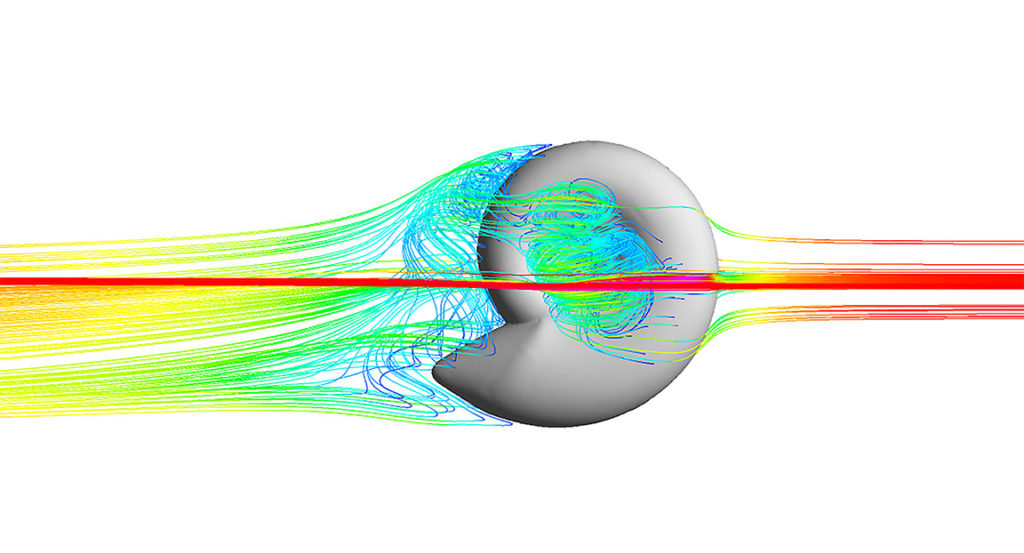Three scientists affiliated with the University of Utah’s department of geology and geophysics will present research on the width, coil diameter and the overall structure of the prehistoric cephalopods shells and how these factors affected their swimming patterns at the American Physical Society’s Division of Fluid Dynamics 72nd Annual Meeting on Nov. 25.
Nicholas Hebdon, Kathleen Ritterbush and Yunji Choi use a computational fluid dynamics model to study the locomotion of ammonoids, a group of cephalopods that swam the oceans for almost 300 million years. They went extinct at the same time dinosaurs.
“One of the interesting and hard things about ammonoids is they don’t have any direct descendants today despite their dominance in the past,” said Hebdon. “We’re interested in what this might be able to tell us about the stability of marine ecosystems and how they recover diversity and ecological complexity after drastic extinctions. Since we can’t compare directly to modern descendants, we have to be creative about how we investigate their potential behavior and interactions.”
The scientists examined the change in size and shape of ammonoid shells by researching fossils. Shell shape and size reflected how efficiently cephalopods swam across various geological periods.
“The shapes and sizes of fossil shells we find from any given interval of geologic time – say, the early Triassic or the early Jurassic – are shells produced by whichever branch of the evolutionary tree was flourishing at that time and the shells those species could build in their particular environments,” said Hebdon.
Researching these long extinct swimmers and their adaptation into different ecosystems across millions of years is expected to shed light on the behavior of modern cephalopod ecosystem.
“With squid and octopus’ populations and harvesting efforts on the rise worldwide today, our understanding of their vulnerabilities and strength will be valuable to food source management and conservation efforts,” said Hebdon.
The researchers’ presentation, “CFD Time Machine: Using CFD to Understand the History of Long Extinct Swimmers,” is part of a series of flash oral presentations on biological and low Reynolds number flows starting at 3:20 p.m. in Room 6C on Monday, Nov. 25.
———————– MORE MEETING INFORMATION ———————–
USEFUL LINKS
Main meeting website: https://www.apsdfd2019.org/
Meeting technical program: http://meetings.aps.org/Meeting/DFD19/Content/3770
Invited talks: http://meetings.aps.org/Meeting/DFD19/APS_Invited
Hotel information: https://www.apsdfd2019.org/hotels
GALLERY OF FLUID DYNAMICS
At the Annual Meeting, The Gallery of Fluid Motion will consist of posters and videos submitted by attendees illustrating the science and beauty of fluid motion. More information can be found here: https://www.apsdfd2019.org/gallery-of-fluid-motion
PRESS REGISTRATION
We will grant free registration to credentialed journalists and professional freelance journalists. If you are a reporter and would like to attend, contact [email protected]. We can also help with setting up interviews and obtaining images, sound clips or background information.
LIVE MEDIA WEBCAST
A press briefing featuring a selection of newsworthy research will be webcast live from the conference on Monday, Nov. 25. Times and topics to be announced. Members of the media should register in advance at https://webcast.apswebcasting.com/go/aps-nov25-19.
ABOUT DFD
The Division of Fluid Dynamics of the American Physical Society, established in 1947, exists for the advancement and diffusion of knowledge of the physics of fluids with special emphasis on the dynamical theories of the liquid, plastic and gaseous states of matter under all conditions of temperature and pressure. For more information about DFD, visit https://www.aps.org/units/dfd/.
ABOUT APS
The American Physical Society (APS) is a nonprofit membership organization working to advance and diffuse the knowledge of physics through its outstanding research journals, scientific meetings, and education, outreach, advocacy, and international activities. APS represents over 55,000 members, including physicists in academia, national laboratories, and industry in the United States and throughout the world. For more information about APS, visit https://www.aps.org/.
Original post https://alertarticles.info


